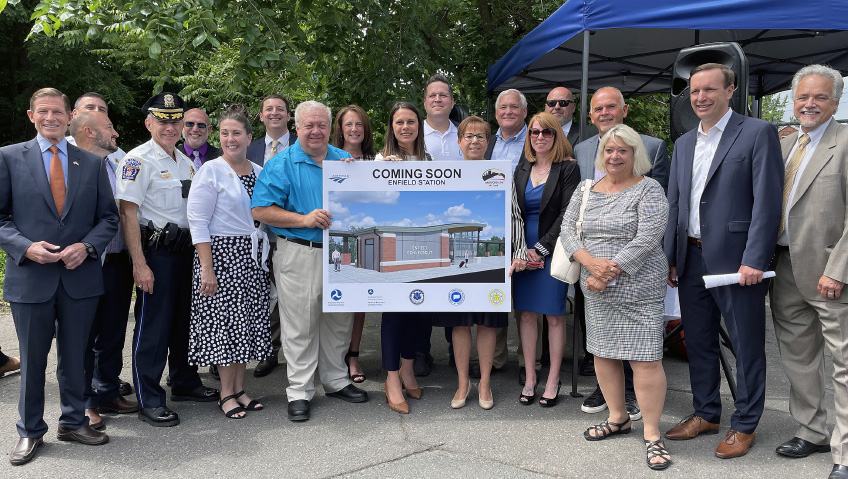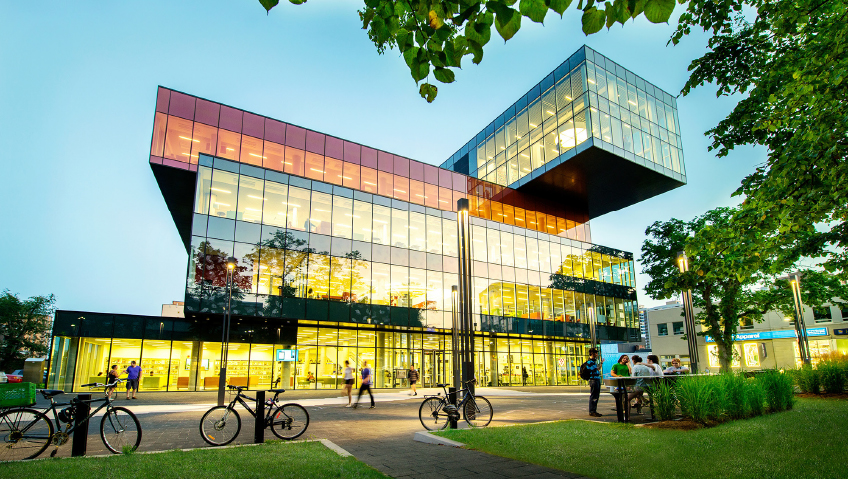Home to 42,000 people and over 3,000 businesses, Enfield, Connecticut is the hub of the Hartford-Springfield interstate area. “It is the largest commercial and economic base for this north central region,” says Town Manager Ellen Zoppo-Sassu.
Originally an agricultural and industrial center—and the largest carpet producer at the turn of the 19th century—the town continues to grow into its full, 21st century potential. “That entire downtown area is now being revamped into a transit-oriented development area,” Zoppo-Sassu reports.
Located within the densely populated community of Thompsonville alongside I-91 and the Connecticut River, the spot is ripe for development, starting with a new train station. “That train platform is going to allow a lot of people to come in and out of Enfield for jobs, for shopping, for recreation,” Zoppo-Sassu says. “But it’s also going to allow residents who may be in one-car families or maybe without cars—some of our lower socioeconomic families—to actually procure employment outside of Enfield as well.”
There is also a large-scale housing development underway in Thompsonville. “We are demolishing two older buildings to make way for upwards of almost 60 units, brand new housing which will be very attractive to that community.” Armed with a state grant, the Opera House Players community theatre is also coming to town and an old church is being renovated to host its productions. “We have a couple of local developers who are taking certain smaller buildings and doing a complete revamp as well,” says Zoppo-Sassu. “So all of a sudden, in Thompsonville, you’re starting to connect the dots about the vibrancy of what that could be in terms of a walkable area, but also as part of a larger transit-oriented district.”
The Bigelow-Hartford Carpet Mills, which were once sprawling brick factory buildings, were converted to over 465 apartment units several decades ago. Now, those apartments will be a prime location for commuters or anyone eager to take advantage of Thompsonville’s new transit station. “People in those apartments—plus everybody else in Thompsonville—can literally walk out their door, get on a train, and go to Springfield, go to Hartford,” Zappo-Sassu says. “They could even go to New Haven if they really needed to. So there’s a lot of excitement about development in that part of town.”
Revitalizing Thompsonville has positive, far-reaching consequences for the entire region. “If there’s economic vitality in your poorest area, that actually springboards and benefits the community as a whole,” Zoppo-Sassu says. “It’s really akin to the philosophy of rising tides lift all boats.”
Indeed, town leaders are eager to spread understanding of this concept throughout the community. “There’s messaging that needs to be done [that] we’ve been working on from a marketing and rebranding standpoint that no, not every dollar goes to Thompsonville—there is money being spent in other parts of the community—but every dollar spent in Thompsonville actually provides a bigger bang for your buck [when it comes to] economic vitality because communities are judged upon median household income data, especially when retail businesses are evaluating whether to locate here.”
Messaging and rebranding in general is becoming a bigger focus for town leaders. After several employees moved on to new pursuits, Zoppo-Sassu saw an opportunity to revamp the job descriptions to better fit the town’s marketing needs. “I’ve been able to rebuild the team and look at some of those positions,” she explains. “We’ve taken the opportunity to revisit how we want to use those positions to provide positive messaging to the community. There are a lot of people who live here who don’t know the extent of the generous public services as well as other amenities that exist here. And I think that we have to market to two audiences: the internal audience of the people who live and work here, but also that external, regional audience of people who we want to come to Enfield to shop, to maybe locate their business here, to support businesses, come to a cultural event, those types of things.”
Town leaders are also “looking at bulking up some of our diversity, equity and inclusion initiatives, which I think is the focus of almost every municipality as well as every business over the course of the last few years,” Zoppo-Sassu says. “Another priority is emerging from our COVID bubbles and ensuring that we continue to provide strong and high quality services that have been tested during COVID to the public. Municipalities have had to pivot and learn how to provide services outside of the traditional way, so I think we’re stronger and more resilient for it, but obviously it all links back to the economic value. Taxpayers want to know that they’re getting the biggest value for what they’re paying in taxes and I think that that becomes another critical messaging point.”
To this end, Enfield now has additional funding to better support businesses as they recover and learn to navigate the post-pandemic landscape. “Last year the federal government designed the American Rescue Plan Act (ARPA) and sent millions of dollars to cities and towns,” Zoppo-Sassu says. Enfield received $13 million. “The Town Council set aside a portion of those funds in order to create a small business assistance program. As of October of this year, businesses are going to be able to apply for funds—kind of a grant set up—but they do have to explain what they want to do with the funds, whether it’s to expand, to make permanent outdoor dining, or bring back employees—whatever they need in order to increase the robustness of what they were doing pre-COVID to get back to that point, or to really explore some of the resilience issues that they faced and how they overcame them.”
Looking ahead, town leaders are optimistic that the local riverfront may also become available for development. “The riverfront is an incredible challenge for us because we, the town, do not control any access points except for one of the boat launches, and the state has another boat launch,” Zoppo-Sassu says. “There’s a patchwork of owners that own the piece of waterfront that we are most interested in. One of them is Eversource, which is our public utility for energy, and the other one is a local developer. I am very happy that our staff have redoubled their efforts and we believe that we are engaged in very earnest conversation now with some shared goals about what that [riverfront development] could possibly look like in the next couple of years.”
The recent transit development is certainly helping to move things along. “With the train platform—which is a $34 million investment by the state and federal government—as the centerpiece, all of a sudden everybody’s looking at that waterfront in a little different way and I think that we’re finally inching toward something that’s going to work for everybody amongst all of the complicated, bureaucratic pieces,” Zoppo-Sassu says. “That’s been very exciting. Nothing is for sure, but I’m pretty confident in the next year there are going to be some pretty big announcements about what that is going to look like.”
With enthusiastic town leadership pushing for a stronger, more vibrant community, Enfield may soon reach its full potential. “Enfield is poised on a very exciting path,” Zoppo-Sassu summarizes. Within the foreseeable future, “all of your needs are quite possibly going to be met within the town borders.”






